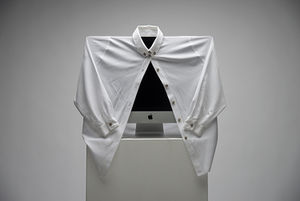How To Be More Or Less Human: Difference between revisions
No edit summary |
No edit summary |
||
| Line 2: | Line 2: | ||
|Creator=Max Dovey | |Creator=Max Dovey | ||
|Date=2015 | |Date=2015 | ||
|Bio= Max Dovey [UK] is 28% man, 14% artist and 8% successful. His performances confront how computers, software and data affect the human condition. Specifically he is interested in how the meritocracy of neo-liberal ideology is embedded | |Bio= Max Dovey [UK] is 28.3% man, 14.1% artist and 8.4% successful. His performances confront how computers, software and data affect the human condition. Specifically he is interested in how the meritocracy of neo-liberal ideology is embedded in technology and digital culture. His research is in liveness and real-time computation in performance and theatre. | ||
|Thumbnail=Howtobemoreorless_thumbnail.jpg | |Thumbnail=Howtobemoreorless_thumbnail.jpg | ||
|Website=http://howtobemoreorless.com | |Website=http://howtobemoreorless.com | ||
Revision as of 16:35, 18 May 2015
| How To Be More Or Less Human | |
|---|---|
| Creator | Max Dovey |
| Year | 2015 |
| Bio | Max Dovey [UK] is 28.3% man, 14.1% artist and 8.4% successful. His performances confront how computers, software and data affect the human condition. Specifically he is interested in how the meritocracy of neo-liberal ideology is embedded in technology and digital culture. His research is in liveness and real-time computation in performance and theatre. |
| Thumbnail | |
| Website | http://howtobemoreorless.com |
How To Be More Or Less Human investigates how human activity is classified by image recognition software. Computer vision and the gaze of the webcam become the basis for a performance that explores how online databases form an identity of the human subject.
The installation will be open daily and the performance will take place at 19:30 on Friday 3rd July 2015 and 19:30 on Thursday 10th July 2015.
Abstract (longer)
How To Be More Or Less Human is a performance investigating how humans are identified by computer vision software. Looking specifically at how the human subject is identified and classified by image recognition software, a representation of the human body is formed. The living presence of a human being cannot be sensed by computer vision, so the human subject becomes a quantifiable data object with a set of attributes and characteristics. Seeing ourselves in this digital mirror allows us to reflect on other models of perception and develop an understanding of how the human subject is ‘seen’ by the machinic ‘other’. Looking at ourselves through the automated perception of image recognition can highlight how gender, race and ethnicity have been processed into a mathematical model. The algorithm is trained to ‘see’ certain things forcing the human subject to identify themselves within the frame of computer vision.

